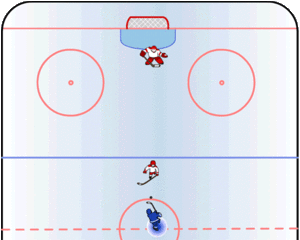Deke (ice hockey)

| Look up deke in Wiktionary, the free dictionary. |
A deke is an ice hockey technique which a player uses to get past an opponent or "fake out" an opposing player.[1] The term is a Canadianism formed by abbreviating the word decoy.
The deke may originally have referred to quickly pushing the puck forward or laterally with the forehand and catching it on the backhand (or vice versa), but as hockey has evolved so has the deke and it is now used to refer to a wide variety of feints, fakes or skillful maneuvers to beat defenders or goaltenders. The position of the player performing the deke and the opponent determines where the puck will be moved and the speed. The deke can be used to move the puck out of reach of an opposing player, move the puck past the opposing player, or quickly change direction of the puck so the opposing player is caught out of position. Dekes are usually used in combination with either a change of direction or speed, or both; the deke may refer to the entire sequence of actions as well as the maneuver(s) made with the stick. Often a change in direction or a change in speed is enough to get past an opposing player, but dekes are used in combination with these to better protect the puck and get by a defender.
In Canada, the term deke has come to broadly mean deceiving someone. It is also used to refer to making a quick detour, for example, "I'm going to deke into the convenience store on my way home."
Dangling
A more complex deke is called a dangle. There are many advanced dangles that players use, and all are customized by the player to suit the situation and his playing style. One such dangle is the toe drag, performed by pushing the puck forward with the forehand before quickly pulling it back with the toe of the blade. A variation of the toe drag is the backhand toe drag. Unlike the backhand shot, this does not refer to going in the opposite direction; rather, the same move is performed but with the wrists turned so the toe of the blade is down and the heel is up, with the puck being dragged with the backhand side of the toe. The angle of the stick adds further confusion for defenders, and the backhand toe drag can flow naturally from a faked shot where the heel of the stick passes over the puck.
Michigan
A "Michigan," also called a "high wrap," or simply the "lacrosse move," is the maneuver of lifting the puck with the stick and throwing it under the top corner of the goal, while skating behind the net, while the goalkeeper protects the bottom corner. Bill Armstrong invented the move, but Mike Legg made it into a permanent sports reel staple while playing for the University of Michigan[2][3][4] Using the Michigan in a full-speed variation, Mikael Granlund scored a goal at the 2011 IIHF World Championship semifinal versus Russia, helping Finland progress into the final.[5][6][7][8][9][10]
Notes
- ↑ "How to Deke". Retrieved 2011-05-18.
- ↑ "The Michigan". youTube. Retrieved 2011-05-18.
- ↑ Hruby, Patrick (2010-04-08). "The coolest goal ever scored in hockey". ESPN. Retrieved 2011-05-18.
- ↑ Ferguson, Pierre P., M.Sc. "How the "lacrosse move" is done". thephysicsofhockey.com. Retrieved 2011-05-18.
- ↑ "Eishockey WM 2011 - Mikael Granlund Tor - Finnland vs. Russland 1:0" (in German). youTube. Retrieved 2011-05-18.
- ↑ "Finnland folgt Schweden ins Finale, Austria" (in German). orf.at. Retrieved 2011-05-18.
- ↑ "Die Russen von den Finnen entzaubert, Switzerland" (in German). nzz.ch. Retrieved 2011-05-18.
- ↑ "Schweden und Finnland spielen um Gold, Spiegel" (in German). spiegel.de. Retrieved 2011-05-18.
- ↑ "Granlunds fräckis fixade drömfinal" (in Swedish). Svenska Dagbladet. Retrieved 2011-05-18.
- ↑ Kimelman, Adam (2011-05-13). "Granlund scores goal for the ages at Worlds". NHL.com. Retrieved 2011-05-18.